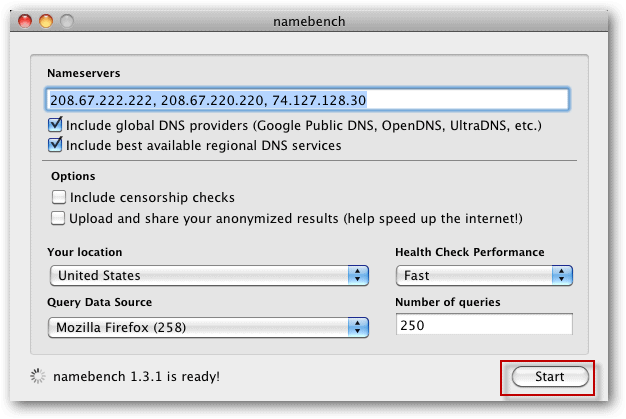
For example, if namebench tells you that Google, Facebook, and Paypal are hijacked, it probably just means that these companies have added IP addresses to their domain that namebench isn’t up to speed on. But in my experience, most of these are false positives. These notes can sometimes flag potential hacking, censorship or hijacking attempts. If you drill down deeper into the results, you’ll get some notes on the actual domain name resolutions. But after I read your answer I digged a bit more and found an excellent explanation here: - quote: Just a small comment first: "namebench" is supposedly a DNS benchmark-script and I'm also not very familiar with it.

8.8.8.8 and 8.8.4.4 as DNS servers instead of the default (from my ISP). Oh, thanks a lot, great suggestion about just setting the DNS and I imagined it would be a good idea to repeat the test, with e.g. There are too many errors/warnings, I think. Question: Is my ISP blocking public DNS-servers or? I don't understand it. Here's a link to the namebench-output (full output): All nameservers have warning: is hijacked: (likely a false positive) All nameservers have warning: is hijacked. (likely a false positive) All nameservers have warning: No answer (NXDOMAIN): static.ak. * Internal 192-1-1 failed test #2/7: Too many warnings (7), probably broken. * DynGuide failed test #2/5: Too many warnings (7), probably broken. Trying again with 6 threads (slow)",ĥ05 of 4514 servers are available (duration: 0:32:47.630533)ĭynGuide-2 failed test #1/5: static.ak.: No answer (NXDOMAIN): static.ak. "How odd! Only 11.2 percent of name servers were pingable. I don't understand the output from namebench.py - especially errors/warning about servers being "hijacked", too many warning, things appear broken (see the list below + attached). I tried the namebench.py script because I wanted to use another DNS-server than my ISP's (default) dns-servers. I want to setup my main router to use DNS-servers that don't belong to my ISP. The gateway at 192.168.1.1 also acts as a DNS-server with the following upstream DNS: I think it's because 192.168.1.1 is also the default gateway. I have the following hypothesis: I have 2 routers, 1 gateway, the other WAP. Fortunately, they are relatively easy to address.Posted: Tue 21:32 Post subject: namebench.py - Is my ISP blocking public DNS-servers?

Even if it is meant well, mistakes sometimes occur. The DNS server you choose plays an important role in this. These improvements work together to increase your overall Internet speed. While there is no silver bullet for improving internet speed, there are numerous minor tweaks and improvements that you can make. Here you need to use the host name of the DNS server instead of the IP address as described below Ĭloudflare: Tap Host name of the private DNS provider. If you select this option, an input window will open. By default, the Private DNS field is set to Automatic. Tap the arrow to expand advanced settings.
#Dns namebench for android#
For Android 9.0 and higher, however, open it settings > Network and internet. The steps to change your DNS on Android vary by device. Then tap Save on computer at the top right of the screen. Tap the button and enter the IP address of your desired provider. The Add Server field appears under DNS Server.
#Dns namebench manual#
Choose Manual to activate further options.

Scroll down the page until you reach the DNS header. This will open a settings page for the wireless network that you want to customize. Tap the ‘ I‘Icon next to your connected network.
#Dns namebench how to#
How to change DNS settings on an iPhoneĪssuming you want to change your DNS server on an iPhone, open it settings > Wireless Internet access. Once you’ve clicked on that + you can enter the IP address of your desired provider.

Unlike Windows, you can easily add and remove DNS servers using the + and – buttons at the bottom left of the window. To change your DNS on a macOS device, open System settings. After clicking on these settings, you will be able to use your new DNS servers.
#Dns namebench windows#
You can then close all settings windows and return to your normal web browsing. You can now repeat the process for IPv6 DNS servers. Choose from here Internet Protocol Version 6 (TCP / IPv6) and click properties. 220.220Īfter entering, click OK to save these settings. Enter the following IP addresses in this area, depending on which DNS provider you want to use:


 0 kommentar(er)
0 kommentar(er)
